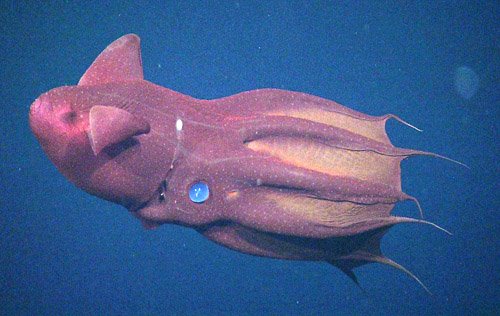Vampire Squid... FROM HELL!
Vampyroteuthis infernalis, known as the Vampire Squid from Hell, does not suck blood or even turn into a bat (lame). So how did it get its name? Well, Dr. Karl Chun discovered them and thought they resembled a vampire from a movie he watched and thought "Why the hell not?" What a wonderful story for a name.

Image Source
These beautiful creatures can grow to a whopping 30cm long (12 inches) and typically feed on marine snow, which is the organic material that falls from the upper ocean to the deep ocean.
It strongly resembles an octopus more than a squid and was originially misidentified as an octopus. This misidentification led to it having its own order, Vampyromorphida, with many extinct species.
The vampire squid has two fins at the top of its body that it uses as its primary propulsion through the ocean but it can also use jet propulsion as well. Its webbed extremeties allow it to reach speeds of up to a little over two body lengths per second, which is quite fast considering how gelatenous its body is.
Vampire Squid Facts
- Vampire Squids have the largest eye in the animal kingdom when compared to body size.
- The have spines on their arms called cirri which they show when threatened as a defense mechanism (see image below).
- They do not possess chromataphores so they cannot change their color.
- They have the ability to essentially turn themselves off and on through use of photophores that covers almost the entirety of their bodies.
These little critters are common prey to whales, seals, and some deep diving fish. I say deep diving because vampire squid live in the oxygen minimum layer of the ocean which is around 90m to 900m deep. Their current population size is fairly unknown and is thought to be quite sparse as males running into females for reproductive purposes is not that common.
Speaking of reproduction, the vampire squid was originally thought to only reproduce once in its lifespan and the mother would care for the eggs until the 13 month gestation period was up and then promptly die. However, this is apparently not the case...
The researchers counted and measured egg cells in 43 female vampire squid (Vampyroteuthis infernalis) netted offshore of southern California. The ovaries in both adolescent and adult females contained thousands of cells that would normally develop into eggs.
But some adult females also carried batches of roughly 100 larger, developing egg cells. If they had not been caught, these vampire squid would soon have released these growing cells as mature eggs. Female vampire squid release each egg individually into the water column.
The authors of the paper discovered that the reproductive organs of female vampire squid return to a dormant, resting stage between rounds of reproduction—something never before seen in soft-bodied cephalopods.
Mbari.org
Image Sources:
Image one
Image two
Sources:
https://oceanservice.noaa.gov/facts/vampire-squid-fish.html
http://www.thecephalopodpage.org/vsfh.php
http://www.seasky.org/deep-sea/vampire-squid.html
http://www.journals.uchicago.edu/toc/bbl/current
https://www.mbari.org/vampire-squid-live-long-and-reproduce-often/
https://en.wikipedia.org/wiki/Vampyromorphida
Sorry for wikipedia as a source, I only used it because it is basically a summary of these papers: Barnes, Robert D. (1982). Invertebrate Zoology. Philadelphia, PA: Holt-Saunders International. p. 461. ISBN 0-03-056747-5.
and
Fischer, Jean-Claude & Riou, Bernard (2002): Vampyronassa rhodanica nov. gen. nov sp., vampyromorphe (Cephalopoda, Coleoidea) du Callovien inférieur de la Voulte-sur-Rhône (Ardèche, France). Annales de Paléontologie 88(1) 1−17. (https://www.sciencedirect.com/science/article/pii/S0753396902010376?via%3Dihub)

Being A SteemStem Member
Downvoting a post can decrease pending rewards and make it less visible. Common reasons:
Submit